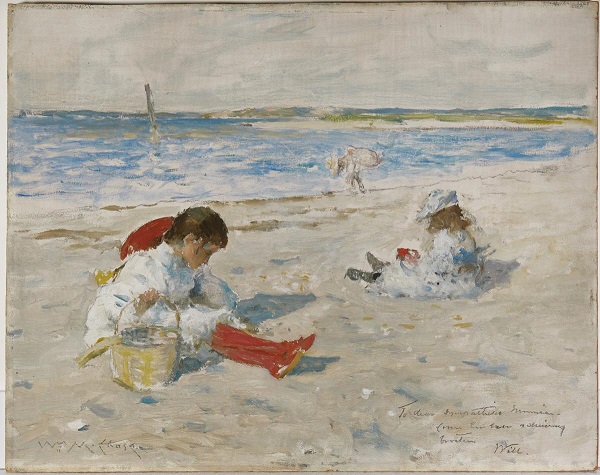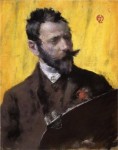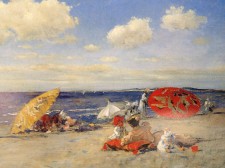
William Merritt Chase
American, 1849-1916
Children at the Beach, 1894
oil on board
12 1/4 x 15 1/2 in.
SBMA, Bequest of Margaret Mallory
1998.50.22

William Merritt Chase, Self Portrait, 1883
"The School of the Impressionists has been an enormous influence upon almost every painter of this time. Most of this work I consider as more scientific than artistic." - William Merritt Chase
“Do not try to paint the grandiose thing. Paint the commonplace so that it will be distinguished”- William Merritt Chase
RESEARCH PAPER
The painting is of Chase’s daughters Alice Dieudonnee, Koto Robertine, and Dorothy Bremond playing on the beach. Alice is in the background bending over looking at something in the sand and seems to disappear into the sea. In the foreground are Koto and Dorothy playing alone in the sand. The composition of the three girls provide balance and form to the image. Chase invokes a pleasant, carefree day for his children at Peconic Beach near their home in Shinnecock Hills, Long Island, New York. (Pisano, Vol. 3, gives the title of this painting as "On the Beach (Beach at Peconic)”.)
The muted colors of white, gray, blue and green give a dreamlike appearance to the painting, and Chase’s use of red provides a color burst with the lighter palette of colors throughout the majority of the painting. There is an atmospheric perspective beginning with the line of the horizon and continuing with the pink and blue clouds across the sky. His light brush strokes and summer like colors conjure a feeling of being at the beach with warm salt air and soft sand under one’s feet. It projects a quality of much light and color being Impressionistic, which was the prominent style of painting during this time period. Of interest is the inscription on the lower right hand corner: “To my dear sympathetic Minnie, from her ever achieving brother Will”. The artist gave this painting to his sister-in-law, Minnie Gerson, in 1894.
In 1891, Chase moved his family to Shinnecock Hills, New York, where he would begin painting landscapes outdoors, brightening his canvas and changing his dynamics of dark studio painting and adopting plein air painting. His early style of painting was very dark and somber, and after a comment made by the Belgium painter Arthur Stevens in 1881, “Why do you want all your works to look like old masters?” (The Preston Morton Collection of American Art, pg. 168) Chase began to lighten his palette. He chose to paint his Shinnecock landscapes with people featured in the drawing, most often his wife, Alice Gerson and their daughters, usually in a manner of everyday movements. The work produced during this era of countryside and beaches of Shinnecock (1891-1902) became the most beautiful and accomplished pieces he painted, and they would come to be labeled as American Impressionism.
Chase was born in Nineveh, Indiana, in 1849, and in 1869 he moved to New York City where he attended The National Academy of Design School. He moved home to St. Louis, Missouri, in 1870, where he painted portraits and attracted some local businessmen who financed and sent him to Europe to attend the Royal Munich Academy from 1872 to 1877. He also visited Venice to paint during that time period.
Returning home he received an invitation to teach at the new Art Students League of New York and continued teaching throughout his life at numerous art schools including The Pennsylvania Academy of Fine Arts, Art Institute of Chicago, Life Classes at Brooklyn, New York School of Art (originally the Chase School of Art). He also established the Shinnecock Summer School in 1891, where he taught every summer until 1902. Chase traveled during the summer (except the Shinnecock years) to Europe to teach and paint from Madrid, Florence, Paris, London, Germany and Bruges until 1913.
In 1878, Chase acquired a studio in the famous Tenth Street Studio Building which he used for painting and social gatherings until 1895. He was friends with both James McNeill Whistler and John Singer Sargent. Chase and Sargent painted portraits of each other, and a self-portrait of Chase from 1908 hangs in the Uffizi Gallery in Florence.
His teaching methods were very expressive, with a great knowledge of technique and allowed his students to develop their own style. He taught some of America’s more famous painters such as Georgia O’Keeffe, Alfred H. Maurer, Hayes Miller and Edward Hopper. From June to September 1914, he taught a summer school class in Carmel, California. This was his last year of teaching. Chase was better known as an accomplished teacher than a painter.
Prepared for the Santa Barbara Museum of Art Docent Council by Merle Guadagnini in 2020.
BIBLIOGRAPHY
Gerts, Wm. H. “Art Across America: Two Centuries of Regional Painting 1710-1920.” Abbeville Press, 1990. Vol 1, pp. 85, 144-45, 152.
Mead, Katherine Harper, ed. “The Preston Morton Collection of American Art” Santa Barbara Museum of Art. Santa Barbara: Haagen Publications, 1981.
Pisano, Ronald D, completed by Carolyn K. Lane and D. Frederick Baker. The Complete Catalogue of Known and Documented Work 1849-1916”,
Volume 2: “Portraits in Oil.” New Haven and London Yale University Press 2006.
Volume 3: “Landscapes in Oil.” New Haven and London Yale University Press 2009.
Santa Barbara Museum of Art. “Chase, William Merritt, ‘Children at the Beach’.” Private website.

William Merritt Chase, At the Seaside, ca. 1892
COMMENTS
Chase's Shinnecock paintings received almost universal praise for their fresh approach to light and atmospheric effects. As one writer put it, "Of the landscapes, Mr. Chase's naturally demand attention first - really, what would an exhibition be without him! - he is all around us with sketches of almost everything, all done in his fine, enthusiastic, breezy way ... These things by Mr. Chase of sea and sky and sandy shore are like a breath of salt-sea air itself - he has somehow managed to bring a bit of even that back to us, as he would a flower." (Orson Lowell, "The Important New York Exhibitions," May, 1898)
As shown especially in At the Seaside, one aspect of Chase's plein-air manner borders closely on the "pre-Impressionist" style of the French artist Eugène Boudin, whose work Chase collected. In addition to sharing similarities in facture, composition, and palette, Chase's seaside paintings and those by Boudin (as for instance the Beach at Trouville) provide more information as to the general custom and popularity of seaside activity than they do the identities of those who participate in it. However, such work as Chase's Afternoon by the Sea and Idle Hours uphold the apparent dichotomy entrenched in his outdoor figure paintings. Despite the ostensible anonymity of the figures, most viewers, like the critic Hartmann, were quick to realize that Chase was, indeed, portraying his family as well as the Long Island landscape. He was painting portraits, but these depicted the family's way of life which, in turn, was orchestrated by him.
- Barbara Dayer Gallati, William Merritt Chase, National Museum of American Art, Smithsonian Institution, 1995
SBMA CURATORIAL LABELS
Chase’s elegant verve is nowhere more evident than in this intimate scene of middle-class leisure – two children, delightedly absorbed in constructing sandcastles on the beach. Executed in a full-blown Impressionist style, Chase expertly captures the feel of the sea air and even the sound of surf and seagulls through quick swipes of the brush and a primarily white palette, shot through with green, yellow and blue touches, and punched up by patches of crimson. The inscription at the bottom corner reads: “To dear sympathetic Minnie. From her ever adoring brother Will.”
Indianapolis born, Chase was fully steeped in the latest avant-garde options in Europe and exerted enormous influence both through his critically acclaimed art and as a popular teacher at the Arts Students League in New York.
- Small-Format American Paintings, 2020
The SBMA sketch, Children at the Beach, has an inscription on the front lower right corner that reads: “To my dear sympathetic Mimmie (sp), From her ever achieving brother, Will”, and it gives a little insight to the artist. In addition to the dedication to the artist’s sister on the front, this charming evocation of family summer activities has a note on the back: “May this sketch give you the same pleasure that it gives me to give it to you. Xmas 1894”.
- SBMA Wall Text, 1999
